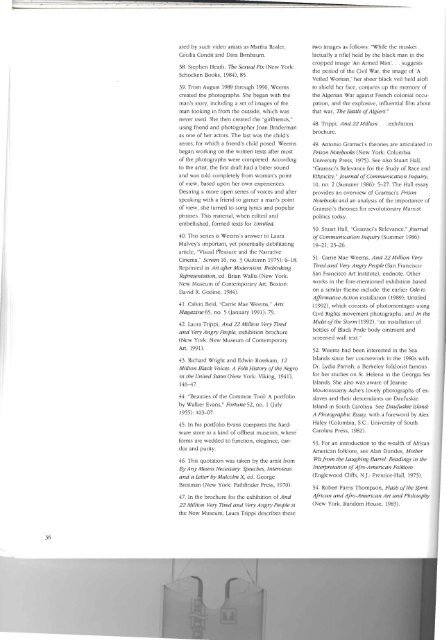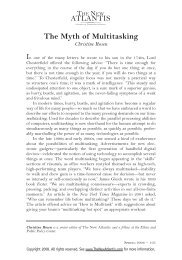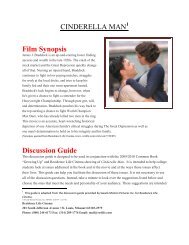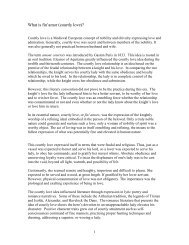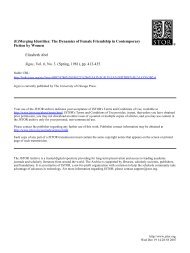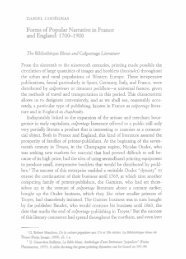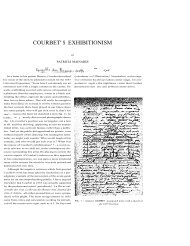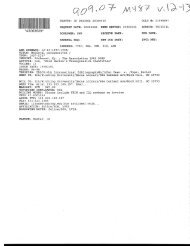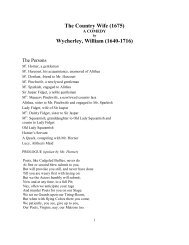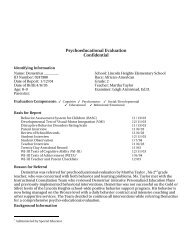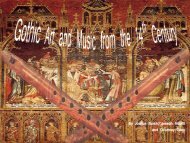CARRIE MAE WEEMS - People Search Directory
CARRIE MAE WEEMS - People Search Directory
CARRIE MAE WEEMS - People Search Directory
Create successful ePaper yourself
Turn your PDF publications into a flip-book with our unique Google optimized e-Paper software.
ated by such video artists as Martha RosJer,<br />
Cecilia Condit and Dara Birnbaum.<br />
38. Stephen Heath, The Sexual Fix (New York:<br />
Schocken Books, 1984), 85<br />
39. From August 1989 through 1990, Weems<br />
created the photographs. She began with the<br />
man's stOlY, including a set of images of the<br />
man looking in from the outside, which was<br />
never used. She then created the "girlfriends,"<br />
using friend and photographer Joan Braderman<br />
as one of her actors. The last was the child's<br />
series, for which a friend's child posed. Weems<br />
began working on the written texts after most<br />
of the photographs were completed. According<br />
to the artist, the first draft had a bitter sound<br />
and was tolel completely from woman's point<br />
of view, based upon her own experiences.<br />
Desiring a more open series of voices and after<br />
speaking with a friend to garner a man's point<br />
of view, she turned to song lyrics and popular<br />
phrases. This material, when edited and<br />
embellished, formed texts for Untitled.<br />
40. This series is Weems's answer to Laura<br />
Mulvey's important, yet potentially debilit3ting<br />
article, "Visual Pleasure and the Narrative<br />
Cinema," Screen 16, no. 3 (Autumn 1975): 6-18.<br />
Reprinted in AI1 after Modernism: Rethinking<br />
Representation, ed. Brian Wallis (New York:<br />
New Museum of Contemporary An; Boston:<br />
David R. Godine, 1984)<br />
41. Calvin Reid, "Carrie Mae Weems," Am<br />
Magazine 65, no. 5 (January 1991): 79.<br />
42. Laura Trippi, And 22 Mtllion Ve1Y Tired<br />
and VelY Angry <strong>People</strong>, exhibition brochure<br />
(New York: New Museum of Contemporary<br />
An,1991)<br />
43. Richard Wright and Edwin Rosskam, 12<br />
Million Black Voices: A Folk History ojthe Negro<br />
in the United States (New York: Viking, 1941),<br />
146-47<br />
44. "Beauties of the Common Tool: A portfolio<br />
by Walker Evans," Fol1une 52, no. 1 (July<br />
1955): ]03-07.<br />
45. In his portfolio Evans compares the hardware<br />
store to a kind of offbeat museum, where<br />
forms are wedded to function, elegance, candor<br />
and purity.<br />
46. This quotation was taken by the artist from<br />
By A ny Means Necessary: Speeches, Interviews<br />
and a Letter by Malcolm X, ed. George<br />
Breitman (New York: Pathfinder Press, ]970).<br />
47. In the brochure for the exhibition of And<br />
22 Million VelY Tired and Very Angry <strong>People</strong> at<br />
the New Museum, Laura Trippi describes these<br />
two images as follows: "While the musket<br />
[actually a riflel held by the black man in the<br />
cropped image 'An Armed Man'... suggests<br />
the period of the Civil War, the image of 'A<br />
Veiled Woman,' her sheer black veil held aloft<br />
to shield her face, conjures up the memOlY of<br />
the Algerian War against French colonial occupation,<br />
and the explosive, influential film about<br />
that war, The Battle ojAlgiers"<br />
48. Trippi, And 22 Million. . exhibition<br />
brochure.<br />
49. Antonio Gramsci's theories are articulated in<br />
PI1son Notebooks (New York: Columbia<br />
University Press, 1975). See also Stuart Hall,<br />
"Gramsci's Relevance for the Srudy of Race and<br />
Ethnicity," Journal ojCommunication InqUiry,<br />
10, no. 2 (Summer 1986): 5-27. The Hall essay<br />
provides an overview of Gramsci's Prison<br />
Notebooks and an analysis of the importance of<br />
Gramsci's theories for revolutionary Marxist<br />
politics today.<br />
50. Stuart Hall, "Gramsci's Relevance," Journal<br />
ojCommunication InqUiry (Summer 1986):<br />
19-21; 23-26<br />
5]. Carrie Mae Weems, And 22 Million Ve7y<br />
Tired and Very Angry <strong>People</strong> (San Francisco:<br />
San Francisco At11nstitute), endnote. Other<br />
works in the fore-mentioned exhibition based<br />
on a similar theme include: the earlier Ode to<br />
Affirmative Action installation (1989); Untitled<br />
(1992), which consists of photomontages using<br />
Civil Rights movement photographs; and In the<br />
Midst oJthe Stonn (1992), "an installation of<br />
bottles of Black Pride body ointment and<br />
screened wall text."<br />
52. Weems had been interested in the Sea<br />
Islands since her coursework in the ]980s with<br />
Dr. Lydia Parrish, a Berkeley folklorist famous<br />
for her studies on St. Helena in the Georgia Sea<br />
Islands. She also was aware of Jeanne<br />
Moutoussamy-Ashe's lovely photographs of exslaves<br />
and their descendants on Daufuskie<br />
Island in South Carolina. See DauJuskie Island.<br />
A Photographic Essay, with a foreword by Alex<br />
Haley (Columbia, S.C: University of South<br />
Carolina Press, 1982)<br />
53. For an introduction to the wealth of African<br />
American folklore, see Alan Dundes, Mother<br />
Wit Jrom the Laughing Barrel Readings in the<br />
Interpretation ojAJro-American Folklore<br />
(Englewood Cliffs, N.].: Prentice-Hall, 1973).<br />
54. Robert Farris Thompson, Flash oJthe Spirit.<br />
;ifrican and AJro-American AI1 and Philosophy<br />
(New York, Random House, ]983)<br />
36


